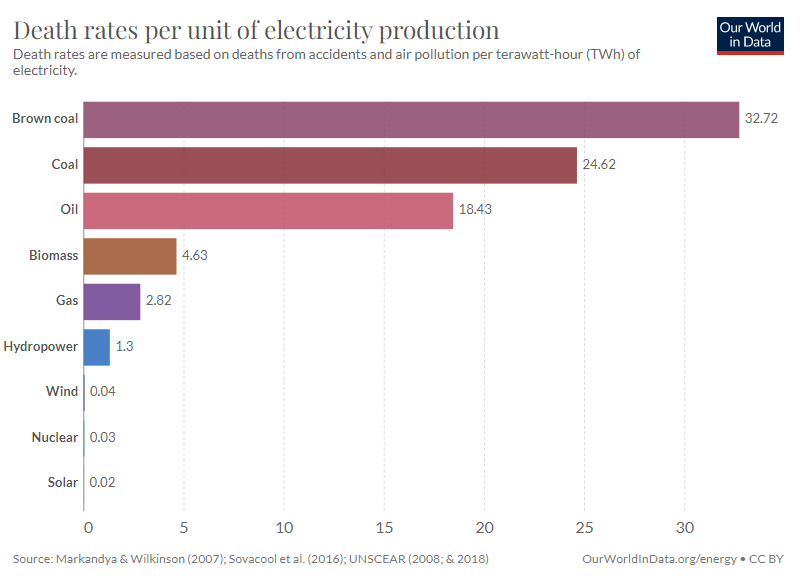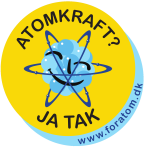You often hear the question of whether nuclear power is dangerous. But the truth is no energy source or technology comes without downsides. So the right question should be: Dangerous compared to what?
The safety of energy sources is assessed on how much energy they each produce and how many deaths are associated with this energy production over the entire life cycle.
Several scientific studies have examined the various energy sources since the 1960s. Each finds nuclear power on par with solar and wind power, while fossil fuels and biomass are the big killers in the energy sector.
Oxford University’s data bank Our World in Data (2022) finds nuclear power has a death rate per produced hourly electricity slightly lower than wind turbines [1]. This includes accidents such as Chernobyl and Fukushima. As can be seen from Figure 1. below.

Air pollution is the biggest killer
About 95% of energy-related deaths come from air pollution. Therefore, fossil energy and biomass are responsible for the highest mortality. Research estimates 8.7 million people annually worldwide die prematurely as a result of this pollution. [2]. In Denmark, the National Board of Health estimates that around 4,000 Danes die annually from this particle pollution [3].

Nuclear power saves human lives
When energy sources replace others with a higher mortality rate, they can actually save human lives. Because nuclear power has been the most effective in replacing fossil energy and biomass, the best research in the field shows that it saved about 1.8 million human lives from particle pollution between 1971 and 2009 [4]
On the contrary, research also shows that when we move in the other direction, mortality increases.
In Germany, 110 more people die annually from particle pollution because the country is phasing out nuclear power [5]. The closure of Svenske Barsebäck in the period 2005-2014 has cost at least 2,400 human lives as a result of an increased burning of fossils [6].
Closing or not building more nuclear power plants thus results in more deaths. Because the energy thus comes from energy sources with higher mortality.
Occupational accidents
Occupational accidents during mining, construction, and operation are significantly lower for nuclear power than for fossil energy renewable energy for two reasons: First, the amount of materials mined, processed, manufactured, transported and built is much less than from fossil and renewable energy per unit of generated electricity. Another is the greater safety culture in the nuclear power industry.
What about the nuclear accidents?
The risk of accidents at nuclear power plants is very low and decreasing. Since 1950 – over a good 6 decades, representing nearly 18,000 cumulative reactor years of operation, nuclear power has remained the safest means of generating electricity per unit of energy produced.
In the period of nuclear power, the world has seen three major reactor accidents.
The first was Three Mile Island in 1979, a contained meltdown with no harm to either people or the environment. The other was Chernobyl in 1986, a flawed design that combined graphite moderation with water cooling that made it extremely unstable and flammable, and built without a containment building that could contain a spill from the core. No reactor in the world is designed like that or built without containment. Up to 50 people lost their lives in the accident. The most recent, Fukushima in 2011, resulted in no injuries or loss of human life as a result of radiation that never reached levels higher than natural background radiation in several places in the world. The people who died were due to panic created by unnecessary evacuation.
Except for Chernobyl, no workers or members of the public have ever died from radiation exposure from a commercial nuclear reactor incident.
The main effects of nuclear accidents were not caused by radiation exposure, but instead were due to psychological and socio-economic factors resulting from misunderstandings and fears about radiation – and therefore could have been largely avoided [7].
Because nuclear power accidents and deaths are so rare, those that do occur are covered with much greater media coverage than accidents and deaths from other conventional energy sources. Often, the media coverage has been of low to strongly critical quality.
Sources:
- What are the safest and cleanest sources of energy? – Our World in Data
- Beskidt luft fra olie, gas og kul dræber 8,7 millioner mennesker om året | Klima | DR
- https://www.sst.dk/da/viden/miljoe/miljoe-og-sundhed/luftforurening
- https://pubs.acs.org/doi/full/10.1021/es3051197
- Atomkraft, Kjernekraft | Forskere: 1100 personer dør hvert år fordi Tyskland faser ut atomkraft (nettavisen.no)
- Environmental and health impacts of a policy to phase out nuclear power in Sweden – ScienceDirect
- What are the effects of nuclear accidents? – World Nuclear Association (world-nuclear.org)




